How Do Animals Use Pheromones To Communicate

This Commodity From Effect
March-April 2015
Volume 103, Number two
Powerful messages can be delivered by odour, a fact known long before the means by which they did and then was discovered. The aboriginal Greeks knew that secretions from a female dog in estrus were attractive to male person dogs. In his beekeepers' transmission The Feminine Monarchie published in 1623, Charles Butler warned that an injured bee's "ranke odour" would attract other angry bees to sting. In the belatedly 19th century, New York's first land entomologist, Joseph Lintner, noted the crowds gathered on the sidewalk outside, looking at the spectacle of 50 wild silk moth males attracted to a virgin female person moth in his office window.
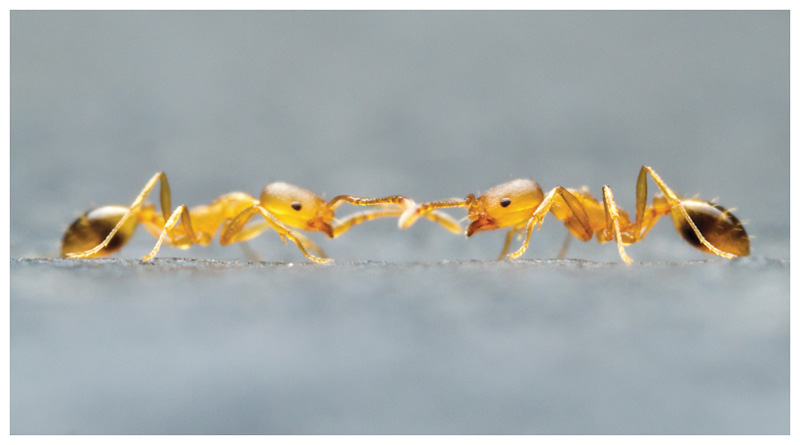
Photograph by Alexander Wild.
Lintner correctly observed that the attraction was probably a chemical, detected by the large, elaborate antennae of the males. He predicted that such an irresistible and far-reaching force could be used to control agricultural pest moths, if only chemists could identify and synthesize these powerful molecules.
Lintner's prediction has been generously fulfilled (see below for "Putting Pheromones to Use"). But because the quantity of pheromone produced past each animal is so small-scale, it was almost seventy years before the kickoff pheromone could be chemically identified, in 1959, by the Nobel Prize–winning German language chemist Adolf Butenandt and his large squad.
In the half century since then, as the technology for isolating and identifying trace amounts of compounds has become more refined, pheromones have been establish in nigh every kind of animal, in squid, lobsters, ants, fish, salamanders, and mice, to name but a few. Although pheromones are important in many species for finding mates for sex, they can have a wide multifariousness of other functions, such as one produced by mother rabbits that prompts suckling by their pups. In many social insects, such as the ants, bees, and wasps, almost every part of colony behavior is mediated by pheromones, from queen signals affecting worker reproduction within the colony to Butler's "ranke smell" alarm pheromone that activates colony defense against enemies.
Pheromones are central to the lives of animals, and in my 30 years of studying pheromone evolution, I accept come up to capeesh the enormous diversity of ways that animals utilize pheromones likewise as how similarly these signals are perceived by scent. Studies of moths, social insects, and mice accept contributed some of the biggest breakthroughs in pheromone research, simply 1 member of the beast kingdom remains a tantalizing mystery: humans.
Pheromones are chemical signals that have evolved for communication between members of the same species. A pheromone indicate elicits a specific reaction in the receiver, for example, a stereotyped behavior (releaser outcome) or a developmental process (primer outcome). Some pheromones can accept both effects. All sorts of molecules, big and minor, have been found acting as pheromones, depending on whether the bulletin is sent out on wind or water currents or placed straight on the nose or antenna of the recipient.
Most pheromones are detected by the sense of smell. Even so, not all smells are pheromones. Mammals, including humans, also give off a cloud of molecules that stand for our unique individual "smell" or chemic profile. These differences between individuals make it possible for dogs to distinguish people past smell. People are quite adept at it, too—parents can distinguish their baby from others by smell alone. Ants similarly can distinguish between members of their ain colony and those from other colonies. In both mammals and insects, learning is necessary to develop this ability. The sources of the molecules that make up an animal'due south "private smell" include its own secretions and also may reverberate its environs, food, bacteria, immune system, and molecules picked up from other individuals in its social group.
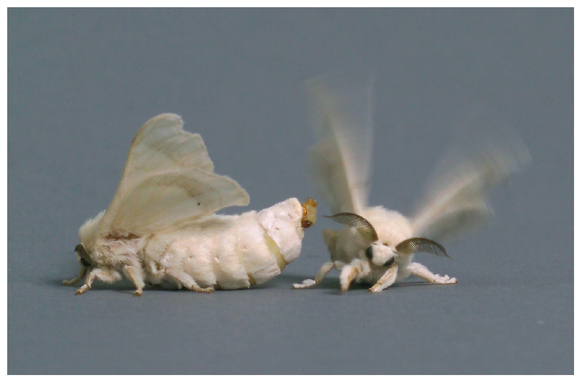
Photo courtesy of Sam Woo.
To definitively demonstrate that a pheromone exists, ane must design a repeatable experiment, a bioassay, that shows that a smell molecule (odorant) causes a particular event on the receiver, for example inducing a behavior. Butenandt used such a bioassay to enable his identification of the showtime pheromone in the silk moth: He observed that males showed excited wing fluttering in response to the odour of mature females (and extracts of their pheromone glands). The wing fluttering response gave Butenandt a bioassay to see which fractions of the excerpt contained the pheromone activity as he attempted the next steps of isolating the possible pheromone molecule. He and his team tested many extracts and identified the sought-afterwards odorant when it induced the telltale fluttering beliefs. They then synthesized the molecule and showed that the synthetic molecules had the aforementioned issue every bit existent female extracts.
These steps are basically the same ones that need to be carried out today to identify the pheromones of any organism, starting with finding a good bioassay. What has changed is that, whereas Butenandt needed 500,000 female moths to get enough material for his analysis, a squad today could attempt much of the assay using just a few individual moths. This is largely due to improvements in engineering, notably gas chromatography linked to mass spectroscopy, simply likewise because nosotros now often know the kind of molecules we are looking for.
Pheromones are smells that have evolved functions as signals. How the sense of smell works was a mystery until 1991, when Linda Buck and Richard Axel, and so both at Columbia University, published their discovery of the highly variable family of almost i,000 dissimilar olfactory receptors in the olfactory organ of the mouse. They received the 2004 Nobel Prize in Physiology or Medicine for this piece of work, which opened a whole new avenue of pheromone research every bit the receptors, including those for pheromones, could now be identified.
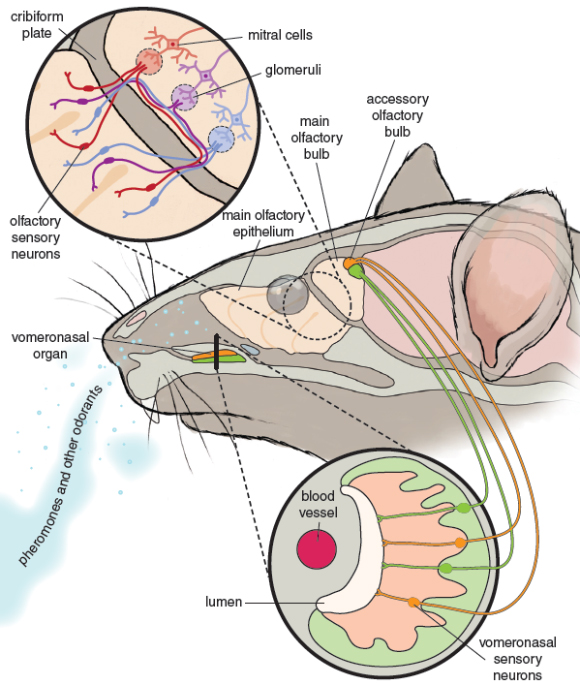
Illustration by Barbara Aulicino.
Odorant molecules interact with these chemosensory receptors, proteins on the surface membrane of olfactory sensory neurons exposed in the nose to the exterior world. When an odorant binds to the chemosensory receptor, it stimulates the nerve to send a betoken to the brain. Buck and Axel also discovered that each olfactory sensory neuron in the mouse olfactory organ carries just i of the one,000 types of chemosensory receptor. All olfactory sensory neurons with the aforementioned receptor type go to the same collection betoken, a glomerulus in the olfactory seedling of the encephalon. In that location is a glomerulus for each receptor type.
Insect chemosensory receptors are so unlike from mammal ones that information technology took almost another decade to find them, and it is probable that they evolved independently from those in mammals.Nevertheless, although the receptors in insects and mammals are very dissimilar, the "wiring diagram" organisation of olfaction is remarkably similar, with all olfactory sensory neurons conveying the same type of receptor going to the same glomerulus in the brain. It could exist that this system evolved independently by convergence, because this is the best manner of organizing chemosensory reception, or it may be that the similar system is a relic of the fashion it was arranged in a distant shared common ancestor.
Small differences in the amino acid sequences of these chemosensory receptor proteins decide which odorant molecules bind to them. Nearly receptors are "broadly tuned"; that is, they are stimulated by a range of similar odour molecules. Conversely, most odorant molecules volition stimulate a range of receptors. The combination of receptors stimulated by an odorant tells the brain what molecule or molecules have been smelled. This combinatorial lawmaking, together with the broad range of receptors, gives olfaction a peachy ability to distinguish different odorants.
The variety of molecules that animals have evolved to use as pheromones is enormous. The diversity is explained past the means that relevant molecules become co-opted every bit pheromones through evolution, my research focus. At a time when nigh scientists accept had to become more narrowly focused, I take had the good fortune to have the opportunity to bring together the results of research on pheromones beyond all kinds of animals to create a unifying evolutionary synthesis, integrating behavioral and molecular levels.
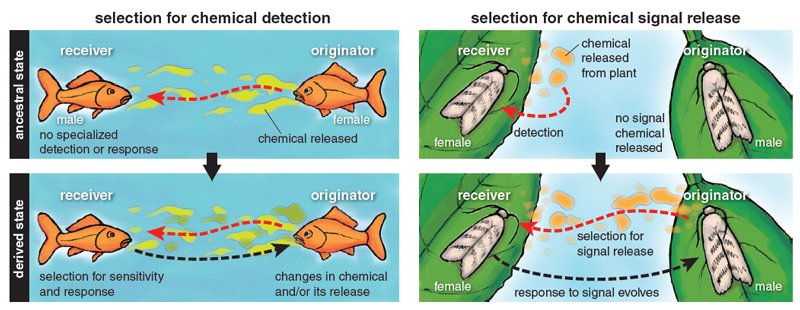
Illustration by Barbara Aulicino.
Odorant molecules became signal molecules in two master ways. The first way is by developing increasing sensitivity for molecules that initially are simply a reliable cue, for example, to finding a sexually mature female. This may be how goldfish sex pheromones evolved. Hormones control the development of eggs in female goldfish, and some of the hormones leak out of their gills into the water. These hormones, or molecules derived from them, have become female-produced sex pheromones, alluring male goldfish. Back in evolutionary time, some males could detect the hormones in the water, using their general broadly tuned olfactory receptors. The most sensitive males would observe the females first, leading to selection over generations for greater sensitivity and increasing specificity of these receptors to avoid false alarms. There would in turn be selection on females to produce these hormone molecules specifically for release, considering females benefit from attracting males to fertilize their eggs, leading to an evolved system of olfactory advice between a signaler and receivers.
The second way is by exploiting preexisting sensitivities of the receiver. The male sex pheromone of the European beewolf wasp Philanthus triangulum, (Z)-eleven-eicosen-1-ol, may have evolved this way. The male sexual activity pheromone exploits a preexisting female sensitivity to this molecule, which is given off by the female person beewolf's prey, honeybees.
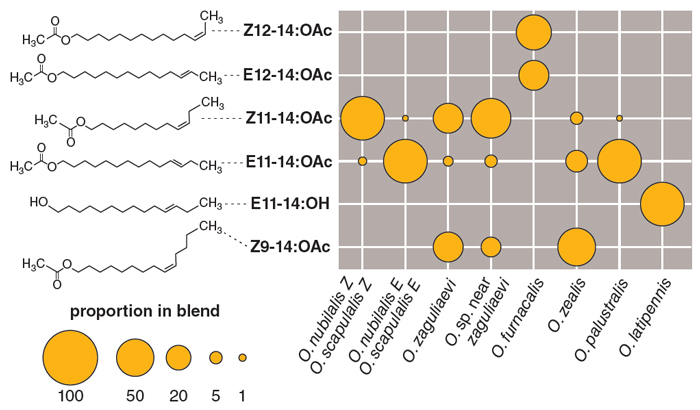
Adapted from J.-G. Lassance, et al., Proceedings of the National Academy of Sciences of the U.Due south.A. 110:3967–3972
In the literature on pheromones, much emphasis is given to their specificity, and their diverseness is central to the story of species divergence and development. Most pheromones are not a single molecule: Instead, particular combinations of molecules grade a multicomponent pheromone. When molecules are added or lost from the
cocktail of molecules every bit species diverge, each new species will have its own specific sex pheromone from these new combinations, even though the molecules themselves may not be specially unusual. For animals that use peptides or proteins as their pheromones, such as newts, a dissimilar amino acid sequence is used to proceeds specificity and avert courting an creature from the wrong species.
Releasing pheromones tin attract more than a mate. Just every bit a singing bird tin can be heard by and concenter a cat, circulate pheromones tin be detected by some predators, and even more sinister, some predators can counterfeit pheromones to lure unsuspecting prey (encounter below for "Spying and Deceit").
Because many moth species are ingather pests, the pheromones of this group take been particularly well studied for their potential in biocontrol methods. Moths provide model systems to explore how animals find their mode to a pheromone source to discover a mate and how animals distinguish between the pheromones of dissimilar related species.
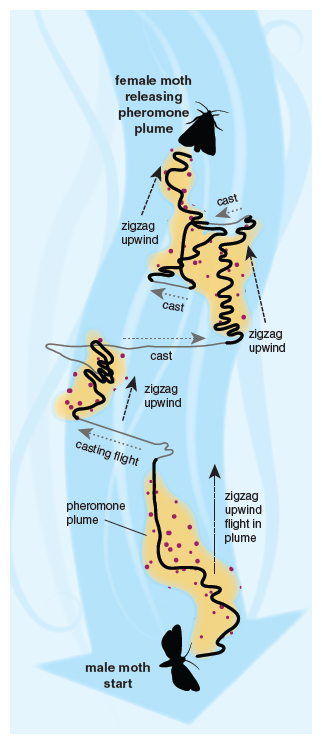
Illustration by Barbara Aulicino.
When a female moth releases her volatile sex pheromone into the night air, information technology is carried by the wind similar an invisible smoke feather from a chimney. The wind shears information technology into pockets of air with pheromone separated by clean air pockets. When a pocket of air with pheromone hits the antennae of a male searching on the wing, he responds by flying upwind for a fraction of a second. If he hits some other pocket of pheromone, he flies upwind again. If he doesn't hit more than pheromone, he flies from side to side until he hits pheromone again. This is a slap-up style of effectively flying upwind towards the female person despite rapidly changing air current directions. This strategy has inspired programming of robots to orient up a chemic feather, and vertebrates such as fish and albatross show similar zig-zag tracks toward an smell source.
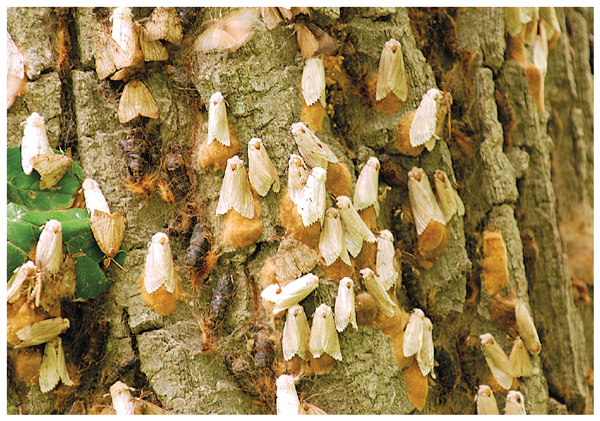
Photograph by Ann Pettigrew.
Well-nigh female person moth sex pheromones consist of a specific combination of molecules. Closely related species apply the same molecules in different ratios or share many, only not all, of the molecules: The differences allow males to distinguish females of their own species from those of other species. Every bit the male person flies upwind he will only respond if the pheromone hitting his antennae contains just the correct combination for his species. On his antennae are the olfactory sensory neurons with specialized receptors. Moth males in species with multicomponent pheromones have one receptor specific for each molecule that makes up the pheromone. If all the right molecules are present, in the correct ratio, so the right combination of nerve cells and their glomeruli are stimulated, sending a message to the higher brain: "Fly upwind." However, the male moths are also sensitive to distinctive molecules in the pheromone blends of related species. If a male moth detects those, he stops flight upwind to avert wasting his time pursuing a female from another species.
Social insects have provided some of the near spectacular examples of pheromone evolution. Pheromones mediate many of the circuitous interplays within colonies of social insects such as bees, wasps, and ants. These include the familiar trails of ants and the honeybee alarm pheromones mentioned earlier. However, pheromones are also essential mediators of ii aspects of the defining feature of social insects, the division of colony members into queens and workers. Only the queen (or a small number of queens) produces fertile eggs.
First, a pheromone "tells" the workers non to reproduce. The signal is a queen pheromone, worn like a crown just by the queen in an ant or honeybee colony. It marks her and also seems to tell the workers that considering she is fertile and laying eggs, the workers practice not demand to practice then. With colonies of up to half a million individuals, pheromones are the just applied way for the queen to send a message to all the workers in the colony.
In many species the workers' ovaries practise not develop if the workers detect the queen pheromone. If the queen is removed and her pheromone is no longer detected, then the workers first to develop ovaries. This property can be used to sensitively test which molecules produced by a queen can act in her absence. University of Leuven'southward Annette Van Oystaeyen and her colleagues used this bioassay to explore queen pheromones in a wide range of ants, bees, and wasps in a recent international report. They showed that in near kinds of ants, bees, and wasps the chemicals are similar nonvolatile saturated long-concatenation hydrocarbons. These queen pheromones, which signal her fertility, are chemically like to and may accept evolved from sexual practice pheromones advertizement fertility in lone ancestor species.
The second primal function for pheromones in social insects is decision-making which larvae become queens in the first place. This is a developmental (primer) result of pheromones on the larvae. In the honeybee, any female person larva has the genetic potential to develop into a worker or a queen, depending on what information technology is fed every bit a larva. If it is fed only royal jelly, a special food produced by nurse worker bees, the larva will develop irreversibly into a queen. The switch is triggered by the primer effects of pheromones in the royal jelly, including a protein called royalactin, recently identified by Masaki Kamakura of Toyama Prefectural University, Nihon. Among the many furnishings of royalactin in the larva are changes in hormone release, which in turn may bear upon which genes are turned on and off via DNA methylation. The queen will be much larger than workers, alive twenty times as long, and accept functioning ovaries to lay upwardly to a million eggs.
Primer effects also occur in mammals. Mice living together may bear on each other'due south reproductive development via primer effects. For instance, exposure to the urine of ascendant adult male mice causes immature female mice to go sexually mature more quickly. However, it is not clear which molecules in the male urine are inducing this primer effect. There have also been questions well-nigh whether these effects occur in the wild, because most accept simply been observed in the laboratory.
Vertebrates, including mammals, use pheromones extensively. In mammals, both small molecules and large proteins have been identified as pheromones. The range of mammals shown to utilize them includes elephants, goats, and pigs, only the best studied is the house mouse, building on its status as a cardinal model species in medical research.
When nosotros switch off the lights and get to bed, the house mouse is in its chemical element. Like many nocturnal animals, information technology has large, sensitive eyes and ears. Merely much more of import is its globe of smells. A ascendant male person spends much of his time crisscrossing his territory, painting drops of his urine on landmarks, boasting his ownership. The volatile smells wafting from the urine marks attract females to come up close to the aroma mark, where they sniff up a nonvolatile protein pheromone, darcin. A message sent to the female'south encephalon prompts her to remember the individual smell of the male who left the mark and besides remember its location. She will render to the spot and mate with the territory owner, recognized by his individual smell.
All vertebrates take a main olfactory system, the olfactory organ. Frogs, salamanders, snakes, and many mammals—simply not humans and other higher primates—also have a second nose, the vomeronasal olfactory system. For a while information technology was thought in error that vertebrate pheromones were exclusively perceived via the vomeronasal organisation. It is now clear that vertebrate pheromones can be detected past either or both olfactory systems, depending on the species. For case the rabbit mammary pheromone is detected by the pups' main olfactory system. There is a meaning overlap even in the size of molecule that is detected by each of the two systems: In the house mouse, while protein pheromones such as darcin are likely only detected by the vomeronasal olfactory organization, pocket-sized molecule pheromones tin can be detected by either system. The two olfactory systems also accept dissimilar families of receptors: A mouse pheromone with primer effects on female oestrus, 2-heptanone, which is detected by both systems, must thus interact with different receptors in each arrangement.
The chief and vomeronasal olfactory systems transport their information to different parts of the encephalon, just these inputs are brought together in the amygdala, a fundamental center for retentivity and motivation higher up in the brain. So, the two olfactory subsystems may do different things, merely there is lots of integration of the inputs—both of pheromone signals and the highly individual smells that allow a mouse to recognize unlike individuals by odour.
It is highly likely that humans, like other mammals, have pheromones. Still, despite the many sites on the Internet offering to sell "pheromones" to make one sexually irresistible, no human being pheromones have been chemically identified to date. Sadly there is no testify for the widely published claims that the molecules androstadienone and estratetraenolare human being pheromones of any kind.
In that location are similar but dissimilar issues with the proffer that women might synchronize their menstrual cycles if living in close quarters, and that this might be mediated past an unidentified pheromone. While some studies accept shown the phenomenon of menstrual synchrony, many others have failed to do so. Moreover, the phenomenon has not been found in women in Republic of mali, West Africa, who withdrew together during menses, a situation that would have been predictable to facilitate the effect.
Another misuse of the term pheromone is in so-called pheromone parties, a trend started by an artist in Brooklyn in 2010. At these events, singles sniff numbered T-shirts that have been worn by others at the party to see if they like the smell and photograph themselves with the shirt in a numbered bag to facilitate meeting upward later. Although these get-togethers might sound similar fun, they are misnamed, because the smells on the shirts are unique to each individual, not species-broad pheromones that trigger the same beliefs in every person. The thought behind these parties is based on the surprising observation that mice preferred to mate with mice that were immunologically different from themselves in the major histocompatibility complex (MHC), a divergence that can be detected by olfactory property. When a similar experiment was tried with Swiss students sniffing T-shirts, it was discovered that women similarly found the scent of men immunologically different from themselves more bonny. However, subsequent replications of the experiment have not shown the effect consistently and, disappointingly, studies of large-scale human being genome information have been every bit inconclusive. Conspicuously, the thought of choosing a potential partner by aroma has popular appeal fifty-fifty though the evidence is non there yet.
A man pheromone would demand to be a molecule (or combination of molecules) that is characteristic not of a particular individual but of all males or all females, for case, that elicits a reliable behavioral or physiological effect on other individuals. The clearest indication that we may yet observe human pheromones in relation to sex activity is considering the smells people give off change after puberty—the sweat and sebaceous glands ramp upward their secretions at that signal. If we were any other kind of mammal, this change would be a prompt to investigate the smells produced by adults. The techniques for taking and analyzing odour samples are at present well established and have been used successfully to identify pheromones in many other mammals. The biggest claiming for work on human pheromones will exist the identification of behaviors and physiological responses that will make robust bioassays. Because of our cultural complexity and diversity, influences on homo behaviors are notoriously difficult to study. Whatever the future studies on humans, they will need to exist guided by the essential steps for identifying a pheromone. There are no shortcuts.
Information technology may exist that the showtime human pheromone to be identified will not have to do with sex but instead with breastfeeding. Finding a mother's nipple just afterwards nascency is a make-or-break moment in the life of a mammal like us, and as I mentioned earlier, other mammals such equally rabbits take a pheromone that attracts newborns to the mother's nipple to suckle.
Developmental ethologist Benoist Schaal and his colleagues from Dijon, France, accept found a secretion released from the areola glands around the nipple of human mothers when they produce milk that causes any infant to open its oral cavity, search for a nipple, and suckle. As yet, nosotros don't know what molecules might be nowadays—finding and identifying them would be a scientific landmark that would give us more confidence in searching for other possible human pheromones. In improver, if we could synthesize this suspected pheromone, in that location could be wellness benefits: If some mothers do non produce enough secretion, supplementing it could perchance solve issues for nearly half of all newborn babies, who do not feed optimally during their start solar day, and the many mothers who struggle to breastfeed. The response of the newborn baby to secretions gives a adept bioassay, because information technology is easily testable and infants are also the human life stage to the lowest degree affected past the complexities of learning and culture. I am optimistic that humans may yet join the countless other species of animal that have been shown to use pheromones.
The progress since Butenandt'southward identification of the silk moth pheromone molecule in 1959 has been extraordinary. The symbiosis between chemists and biologists continues to reveal pheromones in more species of more than kinds of animal than ever before. Apart from the ingenuity of the new chemical techniques for assay, I am constantly impressed by the ways that pheromones are used to report creature advice: In model animals such as the nematode Caenorhabditis elegans, fruit fly Drosophila melanogaster, many moth species, and the house mouse, researchers can study pheromones at every level—from their production through their perception and neural processing—and from every angle, from genes to development.
Entomologists have long realized that moth pheromones could be used to control pest moths, with the added advantage that natural enemies, similar spiders, are left unharmed. In a technique called pheromone mating disruption, synthetic female person pheromone is released in crops or orchards in sufficient quantity that male moths cannot find the existent females. This technique is being used on more than than ten million hectares around the earth. It's especially effective when all local farmers use it, as the apple growers of Washington State have washed to gainsay the codling moth Cydia pomonella. As is ofttimes the case, farmers turned to using pheromones when the moth became resistant to pesticides.
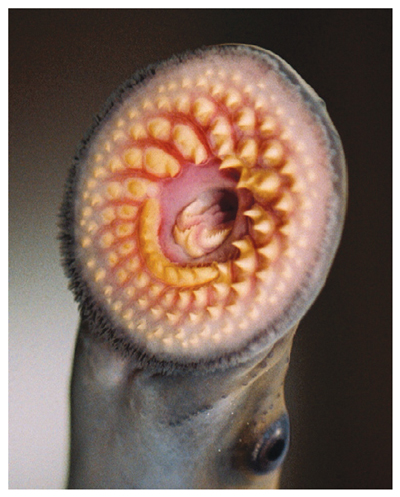
Photograph courtesy of Bully Lakes Fishery Commission.
While the use of pheromones has been well established against insect pests, they could as well be used to control vertebrate pests and human being diseases. For example, invading sea lampreys (Petromyzon marinus), a parasitic jawless fish, have devastated the fisheries of the Groovy Lakes in North America. Research is ongoing to meet if traps baited with the lampreys' pheromones could replace the toxic chemicals currently being used. Pheromones could also be used to tackle human diseases such as those acquired past parasitic nematode worms that utilise pheromones at crucial stages in their life cycle. I target species is the human parasitic nematode Strongyloides stercoralis, a cause of all-encompassing morbidity in the developing world.

Photo courtesy of www.epa.gov.
The species specificity of pheromones is 1 of their big advantages, considering using them for pest control has fewer ecology impacts than broad-spectrum pesticides. All the same, the specificity is a disadvantage for commercial evolution, because each pest species must be studied individually to identify its pheromones. Unlike the development of broad-spectrum insecticides, the inquiry costs are not spread over many pests. The organizations best placed to work on pheromones are universities and government enquiry laboratories, but these are among those scientific institutions most threatened by spending cuts in many nations. Although it is less profitable for corporations, pheromone-based pest control can be highly cost-effective compared with pesticides and has major benefits to the environment, farmers, and consumers.
Broadcast signals can exist "overheard" by unintended recipients. For example, alarm pheromones released by Solenopsis fire ants when fighting ants from other colonies attract unwelcome eavesdroppers: ant-decapitating flies, and so named because these parasitic phorid flies lay their eggs in the heads of ants, which eventually fall off. 1 of these phorid fly species, Pseudacteon tricuspis, might be introduced into the United states of america every bit a possible biological control of invasive fire ants.
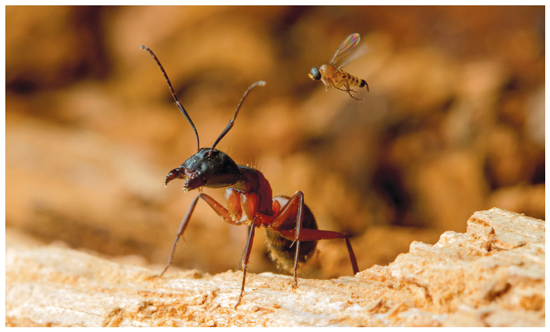
Photograph by Alexander Wild.
Illegal signalers make counterfeit pheromones every bit an aggressive form of mimicry. American bolas spider females lure male moths by mimicking the sex pheromones emitted by female moths of that species. When the male moth comes within range, the female Mastophora hutchinsoni spider swings her mucilaginous "bolas" (her web reduced to a ball). If the bolas touches, moths rarely escape.
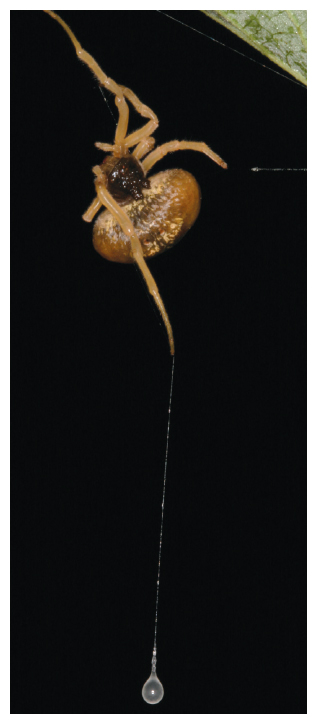
Photo courtesy of Kenneth F. Haynes.
Plants tin can deceive, besides. Instead of giving a nectar reward, many orchids gull male bees into pollinating them past counterfeiting the pheromone of a particular bee species. For example, the European orchid, Ophrys sphegodes, almost perfectly mimics the multicomponent hydrocarbon female person sex activity pheromone blend of the solitary bee, Andrena nigroaenea. Male person bees, attracted by the counterfeit pheromone and the visual mimicry of the orchid blossom, selection up a pollen pack as they endeavor to mate with the bloom. They subsequently make the same mistake again and transfer the pollen to another orchid blossom of the same species.
- Baxi, K. N., K. M. Dorries, and H. 50. Eisthen. 2006. Is the vomeronasal arrangement really specialized for detecting pheromones? Trends in Neurosciences 29:1–vii.
- Cardé, R. T., and One thousand. A. Willis. 2008. Navigational strategies used by insects to find distant, current of air-borne sources of odor. Journal of Chemical Ecology 34:854–866.
- Chamero, P., T. Leinders-Zufall, and F. Zufall. 2012. From genes to social communication: molecular sensing by the vomeronasal organ. Trends in Neurosciences 35:597–606.
-
- De Bruyne, M., and T. C. Baker. 2008. Odor detection in insects: volatile codes. Journal of Chemical Ecology 34:882–897.
- Doty, R. Fifty., 2014. Human pheromones: Do they exist? In: Mucignat-Caretta, C (ed.) Neurobiology of chemic communication. Boca Raton, FL: CRC Press.
- Doucet, Southward., R. Soussignan, P. Sagot, and B. Schaal. 2009. The secretion of areolar (Montgomery's) glands from lactating women elicits selective, unconditional responses in neonates. PLoS ONE 4:e7579.
- Hansson, B. S., and M.C. Stensmyr. 2011. Development of insect olfaction. Neuron 72:698–711.
- Johnson, N. S., et al. 2009. A synthesized pheromone induces upstream movement in female person sea lamprey and summons them into traps. Proceedings of the National University of Sciences of the UsaA. 106:1021–1026.
- Kamakura, M. 2011. Royalactin induces queen differentiation in honeybees. Nature 473:478–483.
- Martin, J. P., et al. 2011. The neurobiology of insect olfaction: Sensory processing in a comparative context. Progress in Neurobiology 95:427–447.
- Roberts, S. A., et al. 2012. Pheromonal induction of spatial learning in mice. Science 338:1462–1465.
- Schaal, B., and S. Al Aïn. Chemical signals "selected for" newborns in mammals. Animal Behaviour 97:289–299.
- Silbering, A. F., and R. Benton. 2010. Ionotropic and metabotropic mechanisms in chemoreception: "chance or design"? EMBO Reports 11:173–179.
- Sorensen, P. W., and B. D. Wisenden (Eds). 2015. Fish Pheromones and Related Cues. Hoboken: John Wiley.
- Van Oystaeyen, A., et al. 2014. Conserved grade of queen pheromones stops social insect workers from reproducing. Science 343:287–290.
- Witzgall, P., P. Kirsch, and A. Cork. 2010. Sexual activity pheromones and their impact on pest management. Journal of Chemical Ecology 36:80–100.
- Wyatt, T. D. 2014. Introduction to chemic signaling in vertebrates and invertebrates. In: Mucignat-Caretta, C. (ed.) Neurobiology of Chemical Communication, pp. 1–22. Boca Raton, FL: CRC Press.
- Wyatt, T. D. 2014. Pheromones and beast behavior: chemical signals and signatures. 2 ed. Cambridge: Cambridge University Press.
Source: https://www.americanscientist.org/article/how-animals-communicate-via-pheromones
Posted by: blanksenone1940.blogspot.com

0 Response to "How Do Animals Use Pheromones To Communicate"
Post a Comment